Woodland Goats
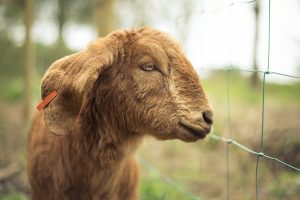
At Tortworth Arboretum we are restoring a 20-acre woodland for community use – clearing an abandoned woodland of ten years of neglect while making it accessible for people to come and learn about nature, as well as improve their mental and physical health and wellbeing. We manage the woodland mostly with hand tools and an ever-evolving team of volunteers who give their time freely to the project. The woodland is host to hundreds of exotic trees from around the world, planted from the 1850s onwards by the local Earl, as well as some stunning veteran oaks and sweet chestnut trees.
And we have goats. Now, I am aware that goats are not the first animal that springs to mind when it comes to managing a woodland, but we had a specific list of objectives that we needed to meet, and goats seemed the best fit. And, as we’ll see, they have proved a huge success.
A thorny issue
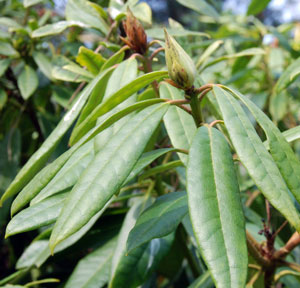 Firstly, we needed to clear the woodland of ten years of under-management. When we inherited the Arboretum, it was under a cover of bramble, scrub, bamboo, and other (tasty) species, as well as rhododendron and laurel. At first, all the work fell to our wonderful team of volunteers, who spend their Sundays cutting back the scrub around our exotic trees (to halo them), reconnecting pathways and reinstating viewpoints. But the volunteer days come round just once a month, and the woodland fights back very quickly; we soon reached the point where we could just about manage to keep cleared areas clear, but didn’t have enough hacking power to expand any further.
Firstly, we needed to clear the woodland of ten years of under-management. When we inherited the Arboretum, it was under a cover of bramble, scrub, bamboo, and other (tasty) species, as well as rhododendron and laurel. At first, all the work fell to our wonderful team of volunteers, who spend their Sundays cutting back the scrub around our exotic trees (to halo them), reconnecting pathways and reinstating viewpoints. But the volunteer days come round just once a month, and the woodland fights back very quickly; we soon reached the point where we could just about manage to keep cleared areas clear, but didn’t have enough hacking power to expand any further.
We tried everything, even burning the bramble and bamboo that we cut back, which would have otherwise formed 20 acres of bramble piles, but this wasn’t a great solution. And then our minds turned – naturally – to goats.
Just a graze
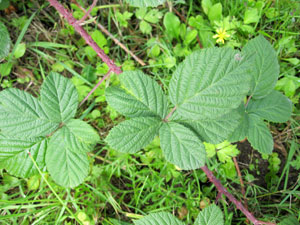 Goats gently graze bramble down, can clear the pathways and help to maintain areas that we have fought back from jungle. This is not to say we don’t have the (rather too frequent) mad dash to the newly planted hedge line to stop them nibbling the tops off our hedging trees. But for our volunteers and visitors, this is all a part of the experience of being in the woods. The only downside is the abundance of rhododendron and laurel which are both fatal if eaten in large enough quantities, but luckily our goats have quickly learned to follow us when we call and stick to the areas that we want them to graze.
Goats gently graze bramble down, can clear the pathways and help to maintain areas that we have fought back from jungle. This is not to say we don’t have the (rather too frequent) mad dash to the newly planted hedge line to stop them nibbling the tops off our hedging trees. But for our volunteers and visitors, this is all a part of the experience of being in the woods. The only downside is the abundance of rhododendron and laurel which are both fatal if eaten in large enough quantities, but luckily our goats have quickly learned to follow us when we call and stick to the areas that we want them to graze.
Our goats are also extremely child-friendly. We hold many children’s events – from family camping weekends to forest school, as well as Outdoor Dads and groups with disabilities – where children can visit the woodland to connect with and learn from nature. Having animals that are full of character, safe around children and easy to look after, means we have another level of engagement for the children that visit.
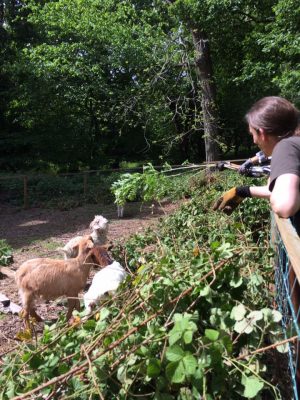 But this connection to animals is not exclusively valuable for children. Most of our conservation programmes and events involve adults with a range of needs, including those recovering from addiction, people with mental health challenges, and adults who are frazzled and stressed from work. We have noticed that those who are not yet ready to join the chattering groups at lunch time will make their way to the goats instead. While we are not quite at the point of offering “goat yoga” (a Facebook phenomenon), we do know that taking the goats grazing is a therapeutic, calming and meditative activity that, for many, is a big part of attending events at the woodland.
But this connection to animals is not exclusively valuable for children. Most of our conservation programmes and events involve adults with a range of needs, including those recovering from addiction, people with mental health challenges, and adults who are frazzled and stressed from work. We have noticed that those who are not yet ready to join the chattering groups at lunch time will make their way to the goats instead. While we are not quite at the point of offering “goat yoga” (a Facebook phenomenon), we do know that taking the goats grazing is a therapeutic, calming and meditative activity that, for many, is a big part of attending events at the woodland.
Knot a problem
We have knotweed. We have LOTS of knotweed, and we don’t want to resort to using chemicals in the woodland unless we absolutely have to – partly because we have rights of way, children’s events and foraging courses – but also because we are not 100% certain that the glyphosate will not affect our veteran and champion trees. Some of the knotweed patches are next to the pathway, some are beside beautiful exotic trees such as out Japanese Horse Chestnut. So, we are using the goats to graze the knotweed several times during the growing season – they have four stomachs which we are pleased to say even the dreaded knotweed cannot (so far!) survive. We are containing the knotweed in this way and hope that in time it will become less vigorous. Ask us in five years for an update – we will make our decisions on chemical use when we see the results of the trial.
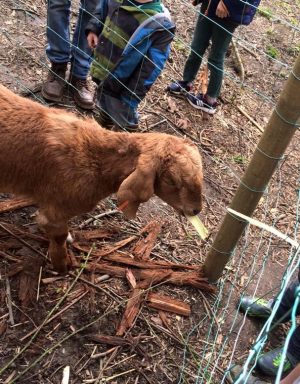 And finally, and perhaps least importantly for our management of the woodland – though very important for the project – is the circular nature of having goats in the woods. They graze the part of the woodland we want them to graze, and give us huge amounts of mulch and manure – this goes to various allotment projects which grow food for our volunteer days.
And finally, and perhaps least importantly for our management of the woodland – though very important for the project – is the circular nature of having goats in the woods. They graze the part of the woodland we want them to graze, and give us huge amounts of mulch and manure – this goes to various allotment projects which grow food for our volunteer days.
Hair today…
Two of the goats are owned by our partner project HoneyWoods. They are angora and so produce mohair, which is dyed using natural dyes from the woodland and spun on drop spindles that we hope soon to be making from our windfall trees such as wild cherry. People who attend our events can see the whole process from start to finish – from feeding the goats that produce the hair, to helping manage the trees that provide the tools to make their yarn. There is something very special about that close connection with each step of the process which helps to connect people with nature, which is our main aim at the woods. We know that people who know and understand their environment are more likely to care for it, and fight for it – as well as being healthier, happier and more fulfilled people. And our goats are a big part of that.
Follow the activities at Tortworth at https://twitter.com/tortworthtrees?lang=en
or https://en-gb.facebook.com/TortworthArboretum/
Tortworth Goats versus Knotweed.
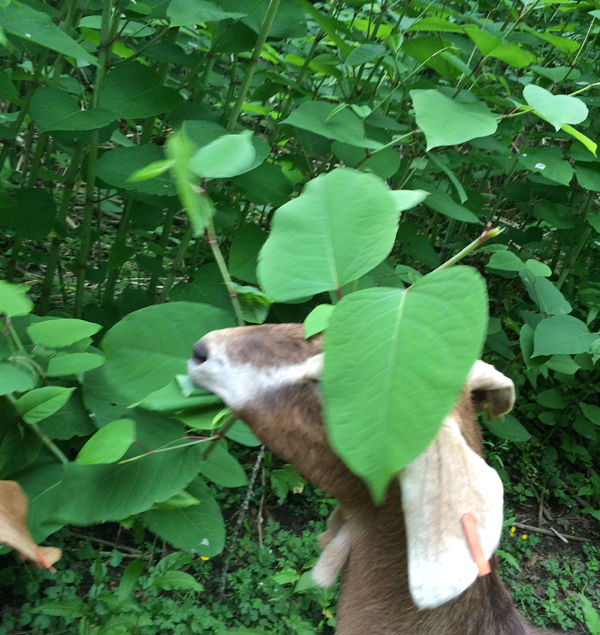

and .......
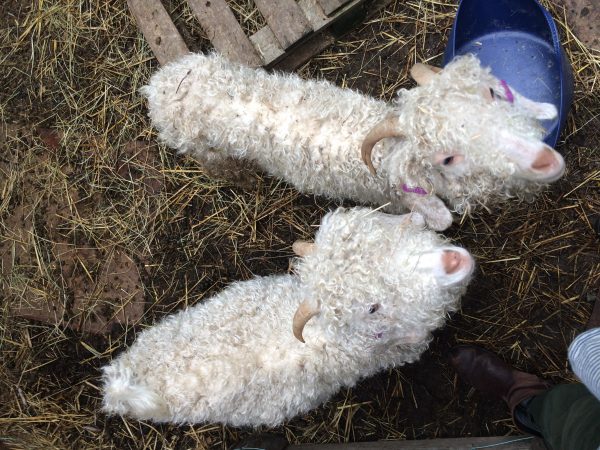
Comments are closed for this post.
Discussion
This is awesome. How are goats with bracken?
How long does it take for them to clear say an acre?
Is it possible to rent goats?
I love your blog!

I am buying a 2 acres of woodland .. how many giid would it sustain please .i was think of pygmy goats.?.would they be suitable .i have owned alpine x goats in the past
Georgina phillips
4 August, 2019